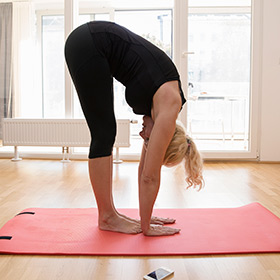Curvature of the spine can happen in adults, even if they never had this in childhood.
Scoliosis, an abnormal curving of the spine, is usually associated with childhood. But adults can develop this problem, too, for a number of reasons.
At the Vanderbilt Spine Center, Byron Stephens II, M.D., is a spine specialist who cares for people with scoliosis. Strategies for treatment depend on how severe someone’s curve is, among other factors. Here, Stephens answers questions about this problem, which becomes more common as people age.
Is adult scoliosis a continuation of childhood scoliosis, or something that develops in adulthood?
There are two types of adult scoliosis. One, called idiopathic adult scoliosis, results from the progression of scoliosis that was present in childhood.
The other type, degenerative scoliosis, does not happen until adulthood. Adult scoliosis usually stems from a problem in the lumbar spine (lower back). Childhood scoliosis usually affects the thoracic spine (the spine running up the mid- to upper back).
What causes adult scoliosis?
Sometimes a fracture or injury can lead to an imbalance in the spine that results in scoliosis. Scoliosis that begins in adulthood can also happen because of arthritis, damage to discs, a complication from a surgery, or having legs of different lengths. Any of these problems can cause the spine to slowly curve more than it’s supposed to.
A common culprit is asymmetrical disc collapse, Stephens said. Most people with degenerative disc problems have spinal discs – the circular cushions of cartilage between vertebrae – that collapse, or get compressed, the same way throughout the disc. But if the disc sinks more to one side than the other, that can lead to a curve.
Is it obvious when someone has scoliosis in adulthood? Do they look like they’re standing crooked?
If someone has a side-to-side curve, that causes relatively few symptoms in adulthood, and it may not be noticeable by looking at someone. They may lose some height due to their curve.
However, a severe curve in the spine from front to back will cause more discomfort. This can prevent someone from standing up straight, which can be quite debilitating.
What are the symptoms of adult scoliosis?
People with this condition often have back pain or pain in one or both legs, though not everyone does. Family members may notice that the affected person’s waist or shoulders are not symmetrical – one hip or shoulder may be higher than the other.
Scoliosis is actually diagnosed and evaluated with special X-rays or MRI imaging.
Can adult scoliosis be fixed?
Many people associate scoliosis with wearing a back brace, but bracing can do more harm than good for adults with scoliosis, Stephens said.
“The nonoperative (non-surgical) treatment of adult scoliosis centers around core stabilization exercises — physical therapy aimed at strengthening our abdomen and our extensor muscles in our back,” he said. “A brace actually can weaken those muscles because it takes a lot of the stress and strain off them.” A brace might be helpful on occasion when someone is doing a strenuous activity, or for someone with an extreme curve who is too ill to tolerate corrective surgery. Otherwise, the most important treatment for adult scoliosis is physical therapy with a therapist who specializes in spine health.
“The point of physical therapy is to ultimately teach the patient the exercises so they can do them on their own,” Stephens said. Over time, doing daily physical therapy work will strengthen the shape and function of the spine.
Usually, adult scoliosis does not lead to surgery. However, if surgery is necessary, a patient should choose a surgeon specifically trained to treat spine deformities. “It can be a complicated problem to treat surgically,” Stephens said. “The good news is technology is advancing all the time. We’re improving outcomes for these patients and really advancing the science of the field every day.”
How can someone prevent a spinal curve from getting worse?
The two best strategies are maintaining a healthy weight – because excess weight seems to worsen a spinal curve – and keeping bones strong and healthy, Stephens said.
“Avoiding osteoporosis is really one of the biggest things” for prevention, he said. “Because the weaker bones are, the faster the curve can progress.” Also, more fragile bones can be a barrier to corrective spinal surgery.
Regular, weight-bearing exercise (for example, walking or lifting weights), getting outside for some moderate sun exposure every day and taking a vitamin D supplement (if your doctor approves) help keep bones strong. These are particularly important strategies for post-menopausal women, whose bones are more at risk than men’s of losing density and therefore strength. Older women should ask their primary care doctor or gynecologist about getting a bone density check.

The Vanderbilt Spine Center treats patients from across the Southeast for back pain, sciatica, whiplash and other conditions of the spine, offering a full range of treatments including non-surgical options. If surgery is necessary, the Vanderbilt Spine Center team provides an extraordinary level of experience and expertise for each patient’s needs. For more information, click here or call 615-875-5100.

